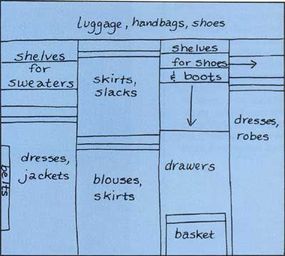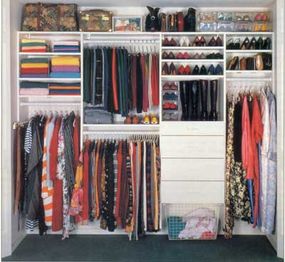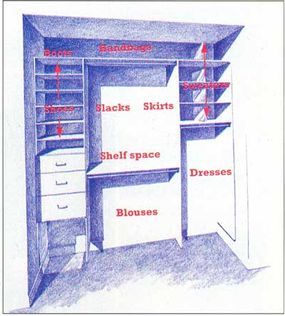You may be facing the same situation in your closet as can be seen in the "before" picture shown below. It can be a disheartening picture. But this article will help you turn that picture into a woman's closet you can be proud of.
Advertisement
You may be facing the same situation in your closet as can be seen in the "before" picture shown below. It can be a disheartening picture. But this article will help you turn that picture into a woman's closet you can be proud of.
Advertisement
First, remove the clothing from the rod and the stacks of merchandise strewed on the shelf and floor. Place these items into groups of similar objects. Calculate how much room you'll need for each group, then measure the space available in the closet -- length, width, and depth. You will then have the numbers you need to formulate a tentative layout. This layout is much like working with a group of building blocks of assorted sizes. Give some thought to the items of a woman's wardrobe that must go in these "blocks" of space: dresses, skirts, sweaters, blouses, high heels, handbags, necklaces, and a range of other items. The closet must have sufficient space to hang the dresses, as well as shelf space designed to fit high-heel shoes, knee-high boots, or wide-brimmed hats. After the hanging clothes have been positioned in the layout, play around with your remaining "blocks" of space, both horizontally and vertically, to fill in the gaps with your accessories.
As with any closet project, the route from a disorganized mess to a neat and orderly closet design starts with establishing a set of standard operational procedures, or handling instructions, for the clothes and accessories that will be stored in the closet. Do not deviate from these guidelines; without standard procedures, you cannot maintain control of your closet.
Advertisement

Remove accompanying belts from slacks, skirts, and dresses. Otherwise, the garments may be stretched out of shape. Belts belong on a belt rack. When hanging slacks, match the inside seam to the outside seam at the bottom edge. Hold the slacks at the bottom, and the crease line is defined. Buttoning or zipping the slacks misaligns the crease. Simply follow the crease line to the waistband and gently mold the zipper and placket into a fold. Then fold the slacks near the middle of their length and insert them onto a hanger, keeping the fold in the center of the hanger. You may prefer to hang your slacks by their full length, which calls for a type of hanger known as a clamp hanger. But be warned: These hangers might mar the cuffs of slacks or the waistbands of skirts by leaving pressure marks that are difficult to remove.
When hanging blouses and dresses, fasten the top button, perhaps the top two, or, best of all, every other button for the entire length of the garment. This eliminates wrinkles, cock-eyed collars, and twisted plackets. After putting the garment on the hanger, place the hanger on the rod so that all hangers face the same direction. Perhaps the worst habit you can get into is deliberately pulling a garment from its hanger. Instead, remove the hanger from the rod and then unbutton the garment from the hanger.
When handbags are placed on a shelf or in a cubbyhole, they should face the same direction and be in an upright position. Create divided compartments for handbags, with each compartment containing one color or a range of colors from light to dark. Closures should be properly buckled, snapped, or tied shut; if the straps or handles can be placed inside the handbag, do so. This stops the straps from getting tangled with other items in the closet.

Advertisement
Each part of your closet can be designed in a variety of configurations. You must determine which aspects of the given designs are most productive and effective for your own circumstances. For instance, in the "after" photograph, what is in the drawers? Lingerie? Socks? Nightgowns? Jewelry? Would the drawers serve you better in the bedroom itself? You must decide for yourself if it is a good idea to place dresser drawers in the closet. If the drawers contain items that are worn repeatedly before they are washed -- such as sweatshirts, sweatpants, jeans, and other garments that you tend to throw on after work each day or for chores and/or leisure activities -- it's a waste of valuable space to stash them in a drawer unit. You would be far better served by placing them on shelves (perhaps behind a cabinet door).
The ideal way to handle these items, as well as robes and other nightwear, is to place a few small hooks in the accessible spaces along the side edges of the closet, or you could develop a system on the inside of the closet door. Also consider the manner in which the boots are stored. These boots could be folded for storage, using less shelf space. It isn't true that your boots will suffer damage from this position.
Advertisement
As you become more aware of your closet space and its various configurations, the problem of seasonal clothes may enter your mind. It can be distressing to look at a wardrobe that contains items you know won't be worn until the fall or spring. On the other hand, it can be a real nuisance to try to find these items in storage when the weather changes quickly. Both methods have advantages and disadvantages, and you must decide for yourself which works best for you.

Of course, the capacity of some closets simply cannot match your needs, despite all your refiguring and diagramming. But if you stick to the basic principles of organizing, your closet will at least provide as much storage space as possible. The most important thing to remember is to group things into categories. One simple rule could save you a lot of space and frustration!
©Publications International, Ltd.
Advertisement
Please copy/paste the following text to properly cite this HowStuffWorks.com article:
Advertisement